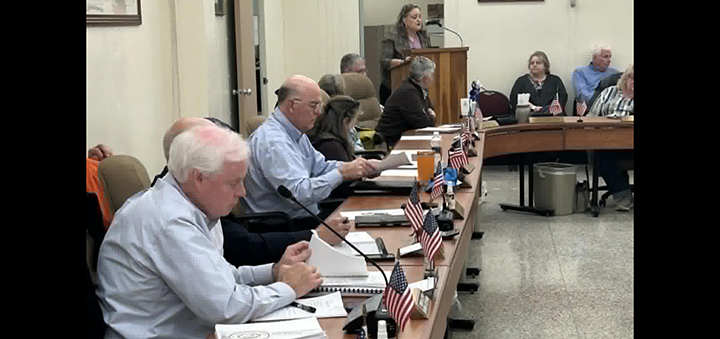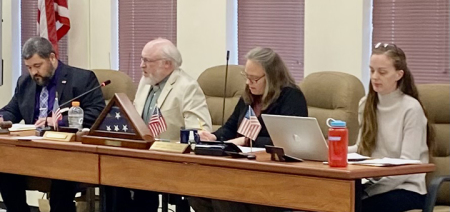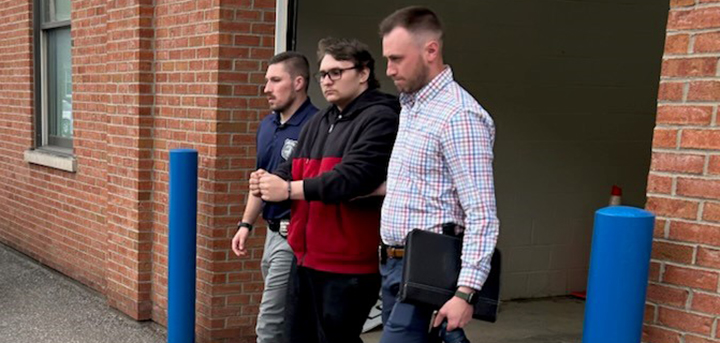Chenango County Passes 2026 Budget; Residents Raise Concerns About Oversight, State Mandates And Long-term Planning
Published:
November 25th, 2025
By:
Tyler Murphy
 Resident Gilda Ward speaks to county supervisors during public comment at a hearing to review the 2026 Chenango County budget. (Photo by Tyler Murphy)
Resident Gilda Ward speaks to county supervisors during public comment at a hearing to review the 2026 Chenango County budget. (Photo by Tyler Murphy)
NORWICH - Chenango County lawmakers adopted the 2026 county budget Monday evening following a 5 p.m. public hearing in the County Office Building, where several residents urged supervisors to consider long-term financial pressures and the impacts of state mandates on taxpayers.
The 2026, $121.4 million spending plan represents a 6.9 percent increase over last year’s appropriations and remains under the state’s 3.74 percent tax cap, staying below the levy limit by roughly $66,000, according to data presented by Chenango County Treasurer Bill Craine.
The budget increases the county tax rate by 30 cents per $1,000 of assessed value, a 1.9 percent rise over 2025, translating to about $27.75 more per year for the average county residence, he said.
Despite a previously approved local resolution permitting the board to override the tax cap if required, county officials said the measure ultimately wasn’t needed.
New York State mandates dominate local costs
More than 78 percent of the county’s tax levy will go toward 15 New York State-mandated programs, an increase from 75.1 percent in 2025. Medicaid alone represents 30.22 percent of the entire levy.
Craine told supervisors that state requirements continue to overwhelm county finances.
“One of the biggest ongoing challenges we face is restoration services for individuals found incompetent to stand trial,” Craine said earlier this week. Those costs are expected to reach $1.2 million this year, roughly 4 percent of all property tax collections.
Craine also cautioned that sales tax receipts, which rose six percent over last year after a disappointing 2023, must continue to meet or exceed national inflation for Chenango County to maintain stability.
“Budgeted revenues are unpredictable,” he noted in the fact sheet, highlighting that any economic downturn could undermine future attempts to stay under the cap.
Residents praise budget effort but warn of strain
Two speakers, Gilda Ward of Guilford and Norwich business owner Missy Hayes, addressed the board, each commending the Treasurer’s Office for offering a clear presentation and professionalism, but they also expressed broader concerns.
Ward, a frequent attendee of county budget hearings, said she was encouraged that the county met all six of its self-imposed financial precepts this year, including staying under the tax cap and maintaining an unassigned fund balance above the county’s $21.6 million minimum.
However, she said taxpayers continue to shoulder the cost for underfunded state programs.
“About 78.15 percent of the 2026 budget is New York State-mandated tax levy,” Ward said. “There needs to be much more reduction of these unfunded mandates that fall on county taxpayers.”
She also urged supervisors to consider the burden future building projects may impose, particularly with residents facing rising costs of living.
“We have many taxpayers barely holding on. An increase in their taxes could cause them to struggle even more, or even lose their property,” she said.
Concerns: DPW, office building project and transparency
Hayes, who along with her husband owns multiple properties in Norwich. She commented on the long-term planning and need for transparency.
She questioned the condition of the county’s aging DPW building, the subject of recent public scrutiny and asked whether years of deferred maintenance reflected a weakness of oversight by the board of supervisors.
“What has been spent on quick fixes and band-aids?” she asked, citing reported emergency roof repairs costing over $100,000. She also pressed the board on whether they or the Environmental Health Department had toured the facility following reports of mold, leaks, and unsafe working conditions.
Hayes additionally challenged the board’s interest in advancing a new county office building project, estimated at up to $35 million, without first demonstrating improved stewardship of current facilities.
“Why would taxpayers expect a different outcome with any new buildings that are built?” she asked. “How can we be sure the same issues won’t repeat?”
She also urged supervisors to make meetings more accessible by livestreaming them, modernizing public records, and using social media to keep residents informed.
Craine described the 2026 plan as steady and responsible, crediting county staff and department heads for keeping expenditures under control.
“We’re very pleased about this year’s budget,” he said. “We try to provide services at the most reasonable cost basis possible.”
The budget maintains the county’s debt-free status, avoids the use of general fund surplus for the third consecutive year, and does not levy any taxes toward the county’s proposed office building or DPW facility projects.
What comes next
Supervisors are expected to receive engineering and design reports for the county office building project in the coming months. A public meeting is planned at 10 a.m., December 2 to discuss the project.
Several residents and some supervisors have called for a more thorough analysis of alternatives including comparing renovations costs or relocating to other sites or creating a phased alternative construction plan before finalizing the project.
Meanwhile, the county continues to navigate demographic and economic headwinds of decreasing population and that the years ahead will likely not be the same as the last few.
According to state fiscal stress indicators, Chenango County has experienced a 3.43 percent population decline and is increasing reliance on state and federal aid.
Both Ward and Hayes emphasized that increased costs for families, and aging county infrastructure should remain at the forefront of supervisors’ consideration.
Following the public hearing, the board of supervisors moved to adopt the 2026 tentative budget.
Author: Tyler Murphy - More From This Author
Comments







